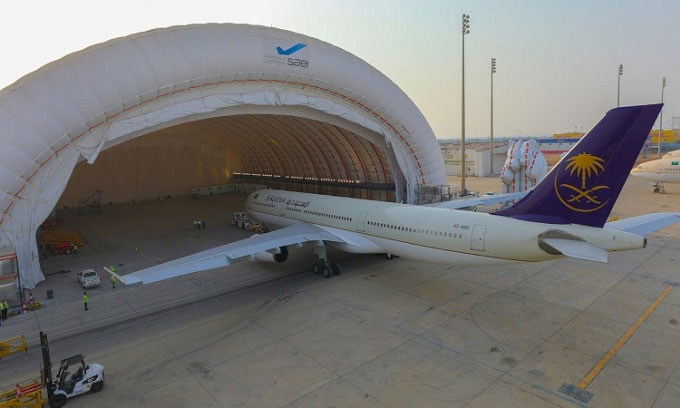Buildair’s inflatable hangar can accommodate large passenger aircraft such as the Boeing 787 or Airbus A330 and has an extremely short construction time.
Opposite the main terminal of King Abdulaziz International Airport in Jeddah stands a large white structure so tall that even nearby jumbo jets seem small in comparison. This is the largest inflatable hangar in the world, built in 2019 by Buildair, a company based in Barcelona that has constructed similar facilities of various sizes at several airports across Europe, Asia, and the Middle East.

Jeddah H75 hangar used for commercial aircraft maintenance. (Photo: Buildair)
Buildair is one of the few companies, including J.B. Roche from Ireland, Aviatech from the UAE, and Aviastroy from Russia, that can deploy inflatable structures on demand. Among these, Buildair focuses on the market segment for very large constructions. A notable project by the company is the hangar in Jeddah, which is used by the aviation services company in Saudi Arabia for commercial aircraft maintenance.
With dimensions of 81 meters long, 75 meters wide, and 25.5 meters high, this facility can house large passenger aircraft like the Boeing 787 or Airbus A330. This record may soon be surpassed as Buildair designs increasingly larger inflatable hangars capable of accommodating the largest passenger jets. The striped appearance of the hangar is due to its construction from inflatable tubes covered in PVC.
Air is regularly pumped in from both ends of the tubes to inflate and maintain the desired air pressure. An automated control system continuously monitors the pressure inside the tubes. Air pressure gradually decreases over time due to slow air leakage, and the gas volume also changes with temperature. To prevent this, Buildair has developed a proprietary technology called AIRTIGHT to seal and secure the structure in place without the need to constantly pump air into the tubes.
One advantage of the inflatable hangar is that, unlike traditional brick and mortar structures, radio frequencies can pass through. Therefore, there are fewer restrictions on where the hangar can be built within the airport. The air inside the tubes acts as insulation, creating an air chamber between the inner and outer walls. The width of the air chamber can reach several meters (for example, the hangar in Jeddah has a 7.5-meter-wide air chamber), allowing technical staff to work inside the hangar at all times and in any weather conditions. The hangar is equipped with lighting, air conditioning, and fire prevention systems.
Inflatable structures do not last indefinitely like conventional hangars and will need to be replaced in the future. However, with proper maintenance, an inflatable hangar can operate for many years. Even if the outer walls show signs of wear due to weather and sunlight, engineers can replace them in sections.
The time from planning to the hangar becoming operational takes less than 3 months. The assembly process can be completed in just a few hours and does not require excavation for installation. Additionally, anchors can be used to secure the structure to concrete blocks or soft ground. In any case, this type of hangar can be dismantled without leaving permanent traces.


















































